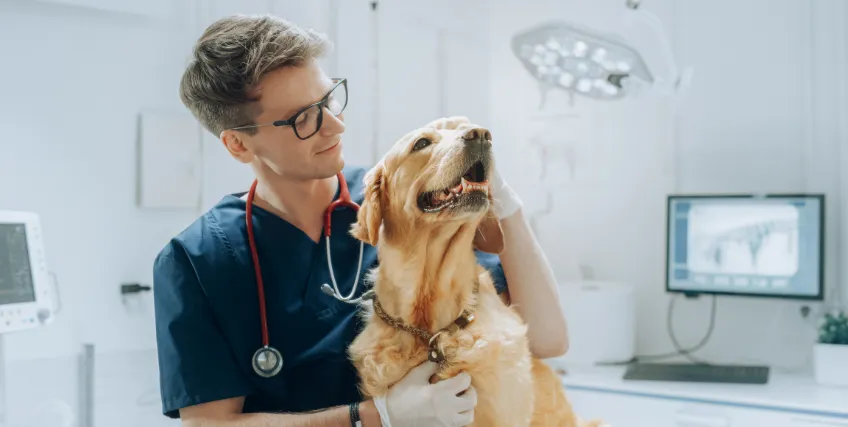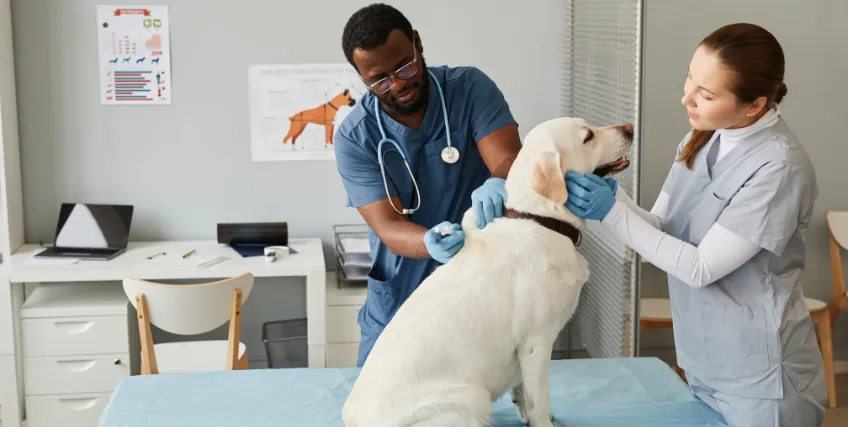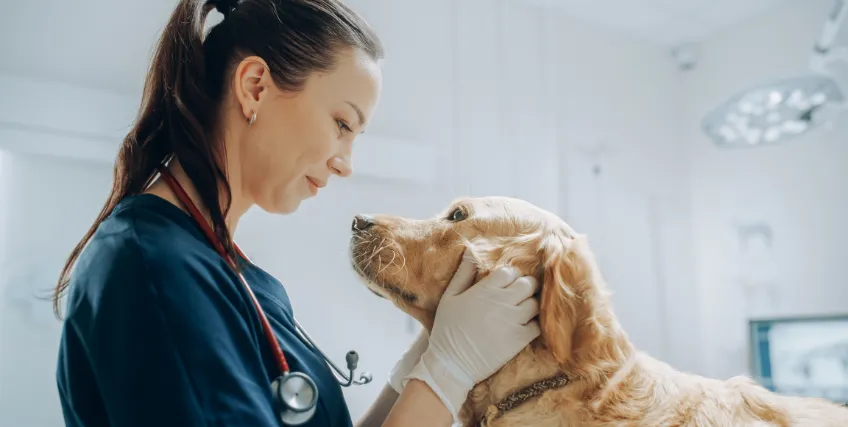Vet Care Financing for Pet Clinics: Fund Routine & Emergency Care
October 28, 2025 | Last Updated on: October 28, 2025

Key Takeaways
- Vet care financing allows clinic to manage different pet needs, veterinary expenses, monthly payments, and operational costs.
- Financing for veterinary care enables clinics to expand services like x-rays, healthcare diagnostics, dental care, wellness, spay, neutering, check-ups, and vaccinations.
- Vet clinics can also partner with providers like CareCredit or Scratchpay to offer payment options and pet financing options for pet owners.
- Also, offering pet insurance and credit card options can improve revenue and give pet parents a peace of mind.
- When seeking loans for veterinary care lenders evaluate credit score, credit history, and revenue stability.
Veterinary clinics in the United States face increasing pressure to maintain high-quality veterinary care while managing rising costs. From vet bills to equipment purchases, vet clinics must balance routine services and emergency pet care. Vet care financing can help clinic owners access capital to grow, modernize, and support their operations.
Many veterinary hospitals struggle with upfront costs, covering veterinary bills, or offering payment plans for pet owners. Hence, with strategic vet care financing clinics can provide financial assistance programs or partner with nonprofits and humane societies to serve their communities.
This article explains about veterinary practice financing, how it works, and what lenders look for. So, here are some of the most effective ways to fund both routine and emergency veterinary services.
Understanding Vet Care Financing
Vet care financing is a funding solution that helps clinics manage operations, invest in equipment, and expand patient services. These loans are specifically designed for veterinary practices by providing capital needed to handle both routine vet care and emergency pet care.
Clinics can use vet care financing options to:
- Manage veterinary expenses: With funding for veterinary practice, clinics can cover vet bills, staff salaries, utilities, and other operational costs smoothly.
- Invest in equipment and technology: Funds can be used to purchase x-rays, diagnostic machines, dental care equipment, and wellness tools. These equipment can be purchase with minimal upfront costs.
- Offer flexible client programs: Clinic owners can use vet care financing to provide payment plans, pet financing, or pet insurance options to pet owners. This helps improve accessibility while maintaining cash flow.
- Handle emergencies efficiently: Veterinary financing options can be used to secure different types of loans to manage unexpected emergency vet care and high-cost procedures.
In short, vet care financing gives clinics the flexibility to grow, maintain high-quality medical care, and meet the evolving pet needs of their community.
How it works
Lenders or financing providers run a credit check and evaluate the clinic’s credit history, credit score, revenue, and repayment ability. Based on these factors, they determine loan amounts, interest rates, APR, repayment terms, and monthly payments.Moreover, vet clinics can also partner with providers like CareCredit or Scratchpay to extend payment options to pet parents while improving their own financial stability.
Vet Care Financing for Emergency vs. Routine Veterinary Services
Clinics manage both emergency vet services and routine care. However, each requires different financing strategies.
Emergency Services:
- Cover emergency pet care, diagnostics, x-rays, and medical care.
- Use working capital loans, business lines of credit, or equipment financing for immediate upfront costs.
- Support vet bills and interest charges without disrupting cash flow.
Routine Services:
- Fund check-ups, dental care, spay, neutering, wellness, vaccinations, and pet health programs.
- Invest in staff training, facility upgrades, and client programs.
- Offer pet financing, payment plans, credit card options, or pet insurance to pet owners and pet parents.
Example:
- Routine wellness programs can be funded via SBA loans or equipment financing.
Emergency x-ray or diagnostic equipment can be purchased using equipment financing or term loans.
Popular Vet Care Financing Options in the U.S.
Clinic owners need access to flexible vet care financing options that cover everything, from routine checkups to emergency pet care. U.S. clinics can choose from a variety of funding solutions that are designed to support veterinary expenses, equipment purchases, and client programs.
Here’s a closer look at vet care financing options:
1. SBA Loans
SBA loans are backed by the U.S. Small Business Administration and are ideal for clinics seeking larger loan amounts. These loans offer longer repayment terms with lower interest rates for qualified applicants . However, lenders evaluate credit score, credit history, revenue stability, and repayment ability to qualify for these loans.
SBA loans can be used by vet clinics for expansion projects, new clinic locations, and various equipment purchase such as advanced x-rays, diagnostics, and dental care equipment. Also, they can be used for various community programs in collaboration with nonprofits and humane societies.
2. Term Loans
Term loans are traditional funding options that provide a lump sum loan amount upfront. These loans typically come with fixed interest charges and a fixed repayment schedule. They allow vet clinics to invest in growth while keeping monthly payments manageable.
Term loans can be used by veterinary clinics for purchasing medical care equipment and expanding services like wellness, spay, neutering, euthanasia, and vaccinations. Additionally, these loans can be used for facility upgrades or renovations.
3. Equipment Financing
Equipment financing is a funding tool designed specifically to purchase equipment. Instead of paying upfront for the equipment here, clinic owners can pay in easy monthly payments with a minimal down payment. Also, the equipment itself serves as collateral, helping clinic owners spread interest charges over the life of the loan.
Equipment financing can be used to purchase tools like x-rays, diagnostics, dental care equipment, or wellness machines. This option ensures clinics can maintain high-quality veterinary care without straining cash flow.
4. Working Capital Loans
Working capital are short-term loans that provide flexible access to funds for veterinary expenses. These loans ensure clinics can continue operations smoothly, even during seasonal fluctuations.
Veterinary clinic owners can use working capital loans for unexpected emergency vet care costs, operational expenses like staff salaries, utilities, and veterinary bills, and payment plans or pet financing for clients.
5. Business Lines of Credit
A business line of credit is a flexible financing option, providing easy access to funds up to a predetermined limit. Clinic owners can draw funds when needed and pay interest only on the amount borrowed.
A line of credit can be used to cover emergency veterinary services, supporting routine check-ups, wellness, and dental care. Also, it can be used for funding client payment options, pet insurance, or deferred interest programs.
Partnering with Providers for Client Payment Options
Offering pet financing to pet parents improves revenue and client satisfaction. Clinics can collaborate with:
- CareCredit: Offers deferred interest and structured payment plans.
- Scratchpay: Provides short-term credit options for emergency pet care and routine vet bills.
Community Programs:
- Partner with nonprofits and humane societies for spay and neutering programs.
- Offer discounted or funded vaccinations, wellness, and check-ups for underprivileged pet owners.
- Clinics can use financing veterinary care options or loan for veterinary care to cover their contribution and maintain operations.
Veterinary Practice Loans: What Lenders Look For
When applying for loan for veterinary care, lenders evaluate:
- Credit Score and Credit History: Strong credit history improves credit approval chances.
- Revenue and Cash Flow: Demonstrates the ability to handle monthly payments and interest charges.
- Business Longevity: Established veterinary clinics and veterinary hospitals often receive better APR and loan amounts.
- Debt-to-Income Ratio: Ensures safe borrowing for veterinary expenses, medical care, and operational needs.
- Business Plan and Loan Purpose: Clear explanation of funding use for emergency pet care, diagnostics, dental care, spay/neutering, wellness, check-ups, vaccinations, or community programs improves approval odds.
The Bottom Line
Managing a veterinary clinic requires capital for both emergency and routine veterinary services. Vet care financing and loans for veterinary care provide clinics with funds for growth, modernization, and client programs.
From SBA loans and term loans to equipment financing, working capital loans, and partnerships with providers like CareCredit and Scratchpay, clinics have multiple financing options.
Strategic planning helps clinics improve pet health, support pet parents and pet owners, manage vet bills, cover veterinary expenses, provide pet insurance, credit card payment options, and maintain operational stability. Clinics can also partner with nonprofits and humane societies for community programs, further enhancing service reach and offering financial assistance to pet owners in need.
Explore vet care financing options today. Pre-qualify with reputable lenders to fund wellness programs, equipment upgrades, and emergency services, helping your veterinary practice deliver top-tier care while protecting cash flow.
FAQs About Vet Care Financing
1. What is vet care financing and how does it work for clinics?
Vet care financing provides veterinary clinics with funds to cover veterinary expenses, purchase equipment, and expand services. Lenders evaluate credit history, credit score, revenue stability, and repayment ability to determine loan amounts, interest rates, annual percentage rate (APR), and repayment terms.
2. Why is vet care financing important for my veterinary practice?
Vet care financing ensures clinics can maintain smooth cash flow, cover vet bills, invest in medical care equipment, and fund both routine check-ups and emergency pet care. It also allows clinics to offer payment plans, pet financing, deferred interest options, or pet insurance to pet parents, improving revenue and client satisfaction.
3. Can financing help clinics offer services to pet owners who can’t pay upfront?
Clinics can partner with providers like CareCredit and Scratchpay to offer pet financing, payment plans, or deferred interest programs. Offering these payment options allows pet parents to access veterinary care like check-ups, spay, neutering, dental care, vaccinations, or emergency services while ensuring the clinic receives timely payment.
4. How can financing support both routine and emergency veterinary care?
Routine veterinary care including check-ups, vaccinations, wellness programs, spay, neutering, and dental care requires predictable funding for staff, supplies, and equipment. Whereas emergency pet care may involve sudden diagnostics, x-rays, or critical medical procedures.
5. Are there options for clinics to support community programs with financing?
Clinics can use financing for veterinary care to fund community initiatives, such as collaborations with nonprofits or humane societies. Programs can include discounted wellness check-ups, vaccinations, spay/neutering, or other pet health services for underserved pet owners.
Frequent searches leading to this page
Related Articles
Term Loans are made by Itria Ventures LLC or Cross River Bank, Member FDIC. This is not a deposit product. California residents: Itria Ventures LLC is licensed by the Department of Financial Protection and Innovation. Loans are made or arranged pursuant to California Financing Law License # 60DBO-35839




